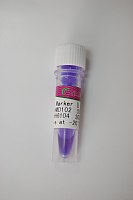DNA Damage Quantitation by Alkaline Gel Electrophoresis
互联网
422
Physical and chemical agents in the environment, those used in clinical applications, or encountered during recreational exposures to sunlight, induce damages in DNA. Understanding the biological impact of these agents requires quantitation of the levels of such damages in laboratory test systems as well as in field or clinical samples. Alkaline gel electrophoresis provides a sensitive (down to ∼2 lesions/5 Mb), rapid method of direct quantitation of a wide variety of DNA damages in nanogram quantities of nonradioactive DNAs from laboratory, field, or clinical specimens, including higher plants or animals. This method stems from studies of velocity sedimentation of DNA populations, and from the simple methods of agarose gel electrophoresis. Over the last ∼15 years, our laboratories have developed quantitative agarose gel methods, analytical descriptions of DNA migration during electrophoresis on agarose gels (1 ,2 ), and electronic imaging for accurate determination of DNA mass. Although all these components improve sensitivity and throughput of large numbers of samples (3 ,4 ), a simple version using only standard molecular biology equipment allows routine analysis of DNA damages at moderate frequencies.







